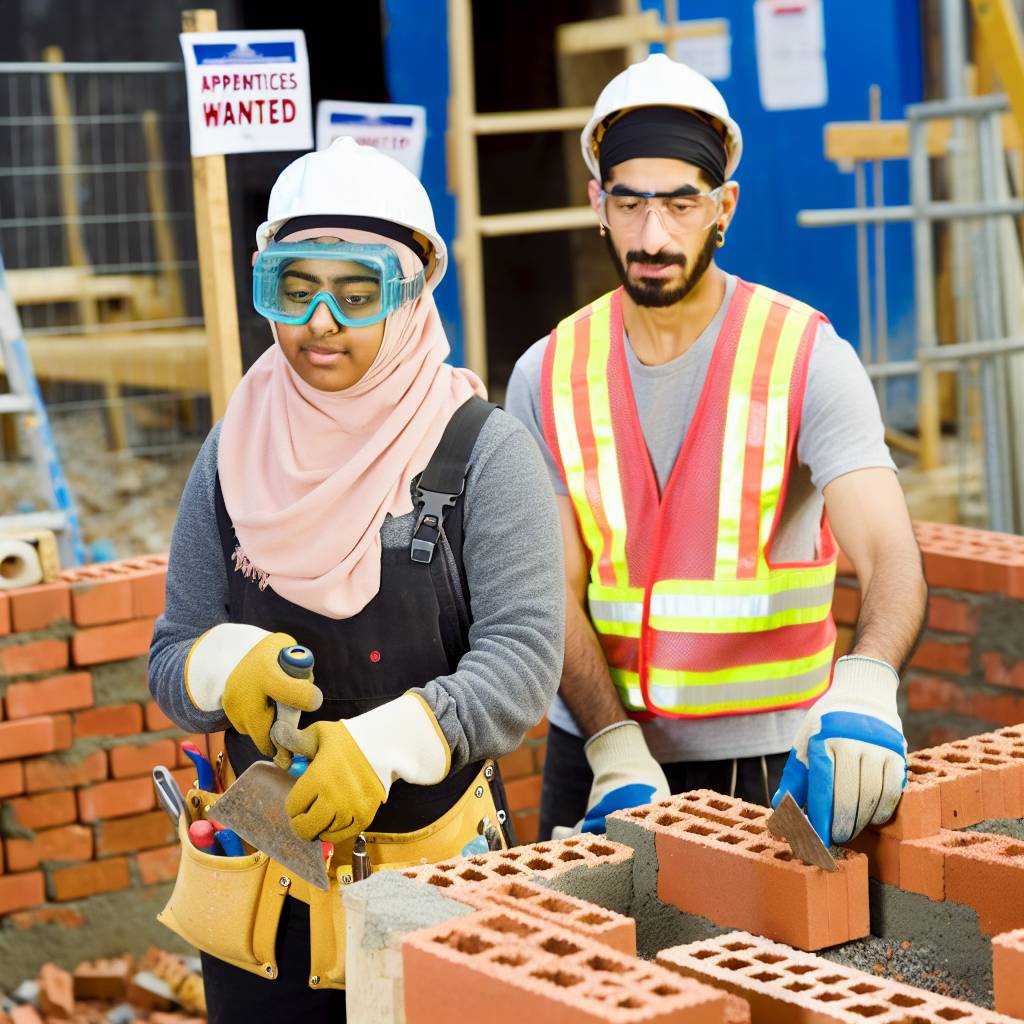Understanding the Role of a Bricklayer in Canada
Overview of Bricklaying
Bricklayers play an essential role in the construction industry in Canada.
They specialize in laying bricks, blocks, and other materials.
Furthermore, they create intricate designs and sturdy structures.
Key Responsibilities
A bricklayer’s responsibilities include reading blueprints and drawings.
They prepare and clean construction sites before work begins.
Additionally, they mix mortar and ensure the correct proportions are used.
Bricklayers must also lay bricks or blocks accurately to maintain structure.
After that, they will finish surfaces by pointing the joints.
Necessary Skills
Successful bricklayers possess strong physical stamina and dexterity.
They need excellent hand-eye coordination to perform precise tasks.
Moreover, they must have problem-solving skills for various construction challenges.
Understanding safety protocols is crucial to minimize hazards on the job site.
Career Opportunities
Bricklayers can find positions in various sectors of construction.
They may work for residential, commercial, or industrial projects.
Additionally, opportunities for self-employment exist for skilled tradespeople.
As they gain experience, many bricklayers advance to supervisory roles.
Job Outlook
The demand for skilled bricklayers continues to grow in Canada.
Urban development and infrastructure projects contribute to this need.
As a result, pursuing a career in bricklaying can be rewarding.
Researching Bricklaying Apprenticeship Requirements by Province
Importance of Understanding Provincial Regulations
Each province in Canada has unique apprenticeship requirements.
Understanding these differences is crucial for prospective apprentices.
Researching helps in making informed decisions about training.
Furthermore, it can streamline the registration process.
Overview of Provincial Requirements
Most provinces require a high school diploma or equivalent education.
In addition, some provinces may necessitate specific courses, like mathematics.
Unlock Your Career Potential
Visualize a clear path to success with our tailored Career Consulting service. Personalized insights in just 1-3 days.
Get StartedAlso, age requirements may vary by province.
Generally, candidates must be at least 16 years old to apply.
Ontario
Ontario focuses on a comprehensive training system.
Apprentices need to complete in-class and on-the-job training.
It’s advisable to contact the Ontario College of Trades for detailed info.
British Columbia
British Columbia requires registration with Industry Training Authority.
Apprentices must fulfill a minimum of 6,000 hours of training.
Moreover, a combination of hands-on practice and theoretical learning is essential.
Alberta
In Alberta, applicants need to complete the related credential exam.
It’s crucial to register through the Alberta Apprenticeship and Industry Training.
Further, apprentices are expected to gain experience in diverse environments.
Finding Reliable Information Sources
Government websites offer up-to-date information on apprenticeship requirements.
For instance, Employment and Social Development Canada has valuable resources.
Trade unions often provide guidance on training programs.
Networking with current apprentices can also provide firsthand knowledge.
Steps to Prepare for an Apprenticeship
Start by researching your province’s apprenticeship requirements thoroughly.
Next, consider relevant courses to strengthen your application.
Connect with local bricklaying organizations for support and guidance.
Lastly, prepare your resume and cover letter specifically for apprenticeship applications.
The Importance of Certifications and Training in Bricklaying
Significance of Certifications
Certifications demonstrate a bricklayer’s skills and knowledge.
They provide credibility to your work, impressing potential employers.
Additionally, certifications often lead to better job opportunities.
Many employers prioritize candidates with recognized certifications.
This is especially true in the competitive bricklaying market.
Types of Training Programs
Various training programs are available for aspiring bricklayers.
Apprenticeship programs are among the most effective options.
These programs combine hands-on learning with classroom instruction.
Additionally, community colleges often offer bricklaying courses.
These courses cover essential skills and techniques.
Benefits of Professional Training
Professional training enhances your bricklaying capabilities.
It equips you with industry-standard techniques and knowledge.
Networking is another significant advantage of attending training programs.
Meeting experienced professionals can lead to job opportunities.
Moreover, trained bricklayers typically earn higher wages.
Requirements for Entry
Before enrolling, check the prerequisites for training programs.
Many require a high school diploma or equivalent certification.
Some may have age and physical ability requirements.
Additionally, prior experience in construction can be beneficial.
It’s essential to review program details before committing.
Explore Further: Why Roofers Are Essential to Construction Projects
How to Create an Effective Resume for Apprenticeship Applications
Understanding the Requirements
Different apprenticeships have specific requirements.
Research the skills and qualifications needed for bricklaying.
Prioritize understanding what employers expect from applicants.
Formatting Your Resume
Your resume layout should be clean and professional.
Use clear headings to separate sections effectively.
Keep font styles consistent to enhance readability.
Writing a Strong Objective Statement
An objective statement should be concise and targeted.
Express your enthusiasm for the bricklaying apprenticeship.
Highlight what you aim to achieve in the apprenticeship.
Detailing Your Skills and Experience
List relevant skills that relate directly to bricklaying.
Include hands-on experience or related coursework.
Be specific about your previous roles and responsibilities.
Consider using bullet points for clarity.
Education and Certifications
Include your educational background, starting with the most recent.
List any certifications related to construction or bricklaying.
Mention relevant training programs you’ve completed.
References and Contact Information
Provide your contact information at the top of your resume.
Include professional references that can vouch for your skills.
Ensure your references are aware they may be contacted.
Uncover the Details: Career Growth Potential for Metal Fabricators in Canada
Utilizing Online Job Boards and Resources for Apprenticeship Listings
Finding Job Boards Dedicated to Trades
Start by researching job boards that focus on trades and construction careers.
Websites like Indeed and Workopolis offer specialized sections for apprenticeships.
Additionally, you can visit provincial job boards for localized opportunities.
Leveraging Social Media for Networking
Social media platforms can be valuable for finding bricklaying apprenticeships.
LinkedIn is a powerful tool for connecting with industry professionals.
You can also join Facebook groups dedicated to construction apprenticeships.
Exploring Company Websites
Investigate local construction companies for apprenticeship opportunities.
Many companies list openings directly on their websites.
Reach out to their HR departments for information regarding upcoming apprenticeships.
Utilizing Government Resources
The Canadian government provides resources for job seekers in skilled trades.
Check the Government of Canada’s Job Bank for apprenticeship listings.
This resource includes details about various apprenticeship programs available nationwide.
Networking with Industry Professionals
Attend local trade shows or networking events to meet industry professionals.
Creating connections can lead to potential apprenticeship opportunities.
Moreover, don’t hesitate to ask for advice or referrals from your network.
Staying Updated with Apprenticeship Programs
Subscribe to newsletters from trade associations in your area.
These newsletters often include updates on training programs and apprenticeship openings.
Stay proactive in seeking out new opportunities through these channels.
Gain More Insights: Financial Planning Tips for Canadian Bricklayers

Networking with Industry Professionals and Joining Trade Associations
Building Professional Connections
Networking plays a crucial role in finding bricklaying apprenticeships.
Attending industry events allows you to meet professionals face-to-face.
Consider volunteering at construction sites to gain more exposure.
Networking not only provides job leads but also increases your visibility.
Connect with local bricklayers and ask for advice on entering the field.
Utilizing Online Platforms
Online platforms can enhance your networking efforts significantly.
Join social media groups focused on bricklaying and construction careers.
Participate in discussions to demonstrate your interest and knowledge.
LinkedIn is particularly useful for connecting with industry professionals.
Share your progress and projects to attract potential mentors.
Joining Trade Associations
Trade associations offer excellent resources for aspiring bricklayers.
Membership often provides access to job boards specifically for apprenticeships.
Associations like the Masonry Contractors Association of Canada can be beneficial.
These organizations also host events that facilitate networking opportunities.
Attending conferences can help you stay updated on industry trends.
Leveraging Informational Interviews
Requesting informational interviews can expand your knowledge and connections.
Reach out to seasoned professionals to learn about their career paths.
This can provide insights into the skills necessary for success.
Be respectful of their time and prepare thoughtful questions in advance.
Follow up with a thank-you note to leave a lasting impression.
Learn More: How to Network Successfully as a Bricklayer
Exploring Provincial and Federal Government Programs for Apprenticeships
Understanding the Importance of Apprenticeships
Apprenticeships provide valuable hands-on experience in the bricklaying field.
They combine practical training with classroom learning.
Furthermore, these programs help bridge the skills gap in the construction industry.
Overview of Provincial Programs
Each province in Canada offers unique apprenticeship programs.
These programs receive support from local governments.
For example, British Columbia offers the Trades Training Employment Program.
It helps apprentices gain the skills they need for success.
Meanwhile, Ontario has the Ontario College of Trades, which regulates apprenticeships.
Federal Government Support
The federal government also plays a crucial role in apprenticeship programs.
It provides funding through various initiatives and training programs.
Programs such as the Apprenticeship Grants offer financial assistance to new apprentices.
Eligibility Criteria for Apprenticeships
Eligibility criteria vary depending on the province and program.
Typically, applicants must be at least 16 years old.
They should also have a high school diploma or equivalent education.
Finding Information about Programs
Finding information about apprenticeship programs is essential.
Start by visiting government websites for your province or territory.
These sites provide information about programs, funding, and eligibility.
You can also contact local trade schools or community colleges.
Contacting Apprenticeship Associations
Apprenticeship associations can be invaluable resources.
They offer guidance and support for finding programs.
Associations like the Canadian Apprenticeship Forum can connect you with opportunities.
Benefits of Enrolling in an Apprenticeship
Enrolling in an apprenticeship offers numerous benefits.
It provides you with industry-recognized training and credentials.
Additionally, apprentices often have access to networking opportunities.
These connections can lead to future job offers and career advancement.
Preparing for Interviews: Common Questions and Best Practices
Understanding Common Interview Questions
Many bricklaying apprenticeships require interviews as part of the selection process.
Employers often ask about your previous experience and skills.
They may inquire about your passion for the trade.
Anticipate questions about teamwork and problem-solving abilities.
Be ready to discuss challenges you faced and how you overcame them.
Additionally, expect queries about your knowledge of safety practices.
Best Practices for Interview Preparation
Research the company and its projects thoroughly before the interview.
Understand their values and mission to align your answers accordingly.
Practice answering common questions with a friend or mentor.
Dress appropriately, showcasing your professionalism and respect for the opportunity.
Arrive on time to demonstrate punctuality and commitment.
Bring copies of your resume and references to leave a good impression.
Engaging the Interviewer
During the interview, listen carefully to the questions asked.
Take a moment to think before you respond to ensure clarity.
Use specific examples from your past experiences to highlight your capabilities.
Show enthusiasm and a willingness to learn about the role and industry.
Ask insightful questions that reflect your genuine interest in the apprenticeship.
Following Up After the Interview
Always send a thank-you email after the interview concludes.
Express your gratitude for the opportunity to interview.
Reiterate your interest in the apprenticeship and summarize key points discussed.
This action helps to keep you fresh in the interviewer’s mind.
Be patient and wait for a response, but feel free to follow-up politely if needed.




